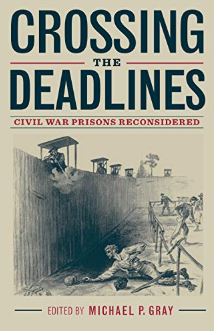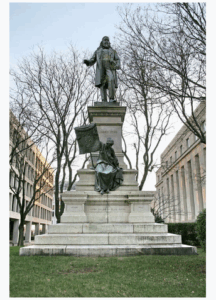Michael Gray, who edited this new book, opens the volume with a historiography of Civil War prisons. Before 1930, while there was a post-war stream of memoirs on the Civil War prisons, there really was a lack of scholarship on the subject. That changed with the publication that year of William Hesseltine’s Civil War Prisons: A Study in War Psychology. Gray writes that the book, published in 1930, is “a trailblazing analysis that has had a lasting impact for scholars.
The book is a balanced argument, based on impartial sources, that maintains neither the North nor the South purposely maltreated its captives; rather, each side was unprepared for them, while imprisoned soldiers were further doomed by the reliance on an irreconcilable exchange system. Moreover, a “war psychosis” developed on home fronts, spurred by propaganda, thereby increasing tensions and, consequently, retribution.

Crossing the Deadlines: Civil War Prisons Reconsidered by Michael P. Gray (Editor) published by Kent State University Press (2018) 256 pages. $45.00 Hardcover, $29.05 Kindle
Hesseltine’s book not only ushered the first scholarly treatment of prisons by a trained historian, but it also followed a quagmire of biased work from the Civil War generation, battling in blame. Shoddy research and writing continued well into the new century, made worse by fictionalized accounts. Civil War Prisons, on the other hand, was considered by many to be the first analysis to set the historical record straight on prisons…”
The publication of the Pulitzer Prize-winning novel Andersonville by Mackinlay Kantor pushed Hesseltine three decades later to step back into the public arena to argue for scholarship over polemnic in examining Civil War prisons. Hesseltine wrote that Kantor’s novel was “uninfluenced by any critical scholarship…. It has excessive length, excessive exposition of the unimportant fornifications of uninteresting people, and an excessive cast of conventional characters. In all of this, the author is perpetuating the myth of Andersonville, capitalizing on the official propaganda and proceeding without benefit of scholarship.”
The novel stirred Hesseltine to battle and it increased his potential readership by expanding public awareness of the forgotten Union and Confederate prisons. It also prompted him to put together the essays that became “Civil War Prisons.”
This new volume of essays aims to bring together some of the seemingly divergent strands of modern scholarship. There are essays here on the environment created by mass internment, the religious aspects of imprisonment, the expereinces of black guards and slaveowning prisoners, and the tourist industry that spand up around some Northern prisons.
In all honesty some of the essays are on topics that I would not have even thought of as fields of study. Yet, all of them are good, and a few are excellent.
Evan Kutzler begins his essay with an oft heard request of National Park staff at Andersonville. The staff like to say that while visitors should not disturb any relics, they are welcome to take some of the park’s copious collection of gnats home with them. Summer vistors heading out of the reception center immediately encounter another aspect of Andersonville’s particular environment; its heat. The fact that a tourist may be more aware of these two facts of visitation should make the importance of environment all too obvious.
Kutzler says that the obvious does not always make it into the history books. He writes:
Environmental approaches to the Civil War have only recently begun to attract attention. Part of this delay has been attributed to the seemingly obvious fact that much of the Civil War occurred outdoors.1 Nature was almost too pervasive a factor in the conflict to be isolated as a field of discrete study. For this reason, environmental considerations have long been a secondary factor for scholars who study the operational or social experiences of prisons. While present in many works, nature often appears as background to a more important human drama. In his 1968 history of Andersonville, Ovid Futch, for example, describes Andersonville’s landscape as it appeared at the time, but largely ignores the Civil War–era environment.
Certainly at the time of the Civil War, the United States Sanitary Commission was very aware of the ways the environment fostered the health or sickliness of the prisoner population. They saw how death rates rose with unsanitary conditions and how stoves, while providing life-saving heat, also spread sooty smoke through camps that compromised men’s respiratory systems.
The Sanitary Commission men were progressive and scientific. They did not want Confederates to die. They made significant efforts to provide better ventilation, drainage, and sanitary facilities. However, when these projects failed, they were likely to blame the Confederates themselves.
In the South, civilians worried that bad smells from urban jails for Unionists were harbingers of disease outbreaks. The concern that Unionists might be destroying the urban environment led to demands that the prisoners be moved further South to rural areas.
This essay was a great way to open the main part of the book. It pushed me to think of the prison experience in ways I had not done before.
While this tourism existed in both the North and South, it was turned into a commercial money-maker in the northern states.
When the Elmira camp opened in 1864, an observatory went up there as well. It was so successful that a second observatory was erected by a competitor. The railroad saw increased numbers of passengers heading to Elmira from New York City, Buffalo, Binghamton, and Rochester and the omnibus line from downtown Elmira to the prison on the westside was overcrowded when tourists were in town.
Locals sold intoxicants to the dark tourists and sex workers made the spree in Elmira into a party. It was a bonus if the dark tourists saw men collapse and die in front of the amused eyes of the well dressed men and women.
In part, this may have been due to the splits in many Protestant churches. The ministers who came to serve the spiritual needs of the prisoners held in the Confederacy came from the Confederacy. The soldiers they ministered to were Union soldiers. So, because of the ecliastical schisms over slavery, Southern Baptists were preaching to Northern Baptists. These two groups were enemies even before the war broke out.
Catholicism, as an international religion administered from Rome, never split in two in the United States. A Catholic priest in Charleston would consider Catholic Union soldiers held in the jail there to be his co-religionists. Since the Catholic Mass consisted mainly of the recitation of an ancient liturgy and reading a selection from the Bible that had been foreordained in Rome years earlier, there was little room for contemporary politics to be inserted into the Mass. So, while Southern Protestants attending services in Elmira often walked out when the preacher began talking about treason and abolition, Southern Catholics were unlikely to find any references to anything other than the “timeless truths of the Church.”
This apparent apoliticism allowed soldiers North and South to find comfort and meaning during the cruel days of their imprisonment.
According to the essay:
The Catholic clergy responded to the Civil War’s crisis of imprisonment by exercising their vocation inside prisons to save souls and comfort the dying. Prisoners, including Protestants, received the Catholic clergy warmly, and these men and women helped mitigate religious tensions. Chaplains taken as prisoners of war were usually allowed to go free—but, paradoxically, Catholic priests in both the North and the South clamored to get into prisons to provide a spiritual bulwark against despair, dispense sacraments, and administer last rites to Catholic inmates who perished as victims of circumstance or suffered execution for malfeasance. Overall, an examination of Catholicism in military prisons illustrates that Catholicism functioned as a means to personal salvation, as a mechanism to galvanize loyalty, and as a polarizing force that either bridged or underscored religious differences.
The good example that priests set led, according to Zombek, to the mitigation of religious differences between Protestant and Catholic prisoners. Protestants who would never have set foot in a Catholic church in their home towns, might drop in on a Catholic Mass to lessen the boredom of prison life. There they could see that the common anti-Catholic tropes of the day were largely false.
Although the priests did not engage in evangelization crusades, they did make converts. Fr. J. Murphy of Camp Douglas in Chicago reported baptizing approximately 250 men. Nuns also worked with the prisoners, setting a high standard for self-sacrifice regardless of the color of the prisoner’s uniform.
The fact that many Catholic priests offered prayers for peace rather than for victory led some Northern Protestant officers to suspect the men in black of disloyalty. Although a sixth of the Union army was believed to be Catholic, old prejudices died hard for some.


